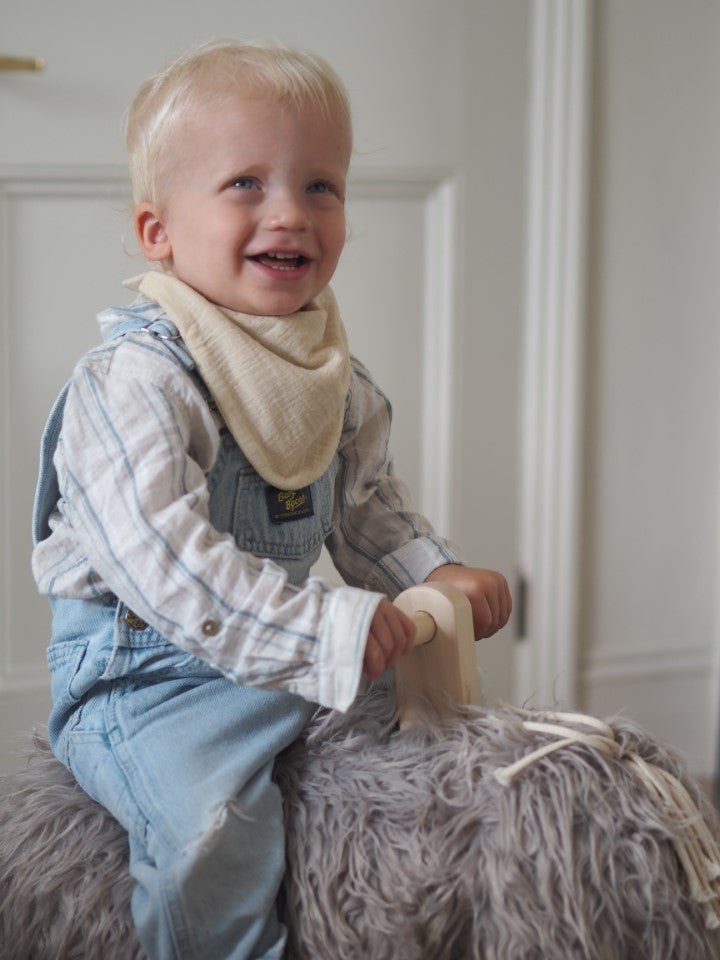
How to Tackle Chin Rash from Dribble Babies
Share
Teething rash, or drool rash, is a common issue for babies, especially during teething when excessive drooling occurs. The constant moisture on their sensitive skin can lead to irritation, redness, and discomfort.
As a parent, it’s essential to manage drool effectively and protect your baby’s skin from developing a rash. Here are some practical tips to tackle chin rash and keep your baby comfortable.
1. Use Soft, Absorbent Dribble Bibs
One of the best ways to prevent and manage chin rash is by using high-quality, soft, and absorbent dribble bibs. These bibs catch drool before it touches the skin, keeping your baby’s chin dry and reducing irritation. Make sure the bibs are made from breathable fabrics like cotton or organic cotton, which are gentle on sensitive skin.
Pro Tip: Look for dribble bibs with adjustable fastenings to ensure a snug fit around the neck without being too tight, which could contribute to irritation. Drool's dribble bibs are perfect for catching all the dribble without irritating skin!
2. Keep the Skin Dry
Constant moisture is one of the primary causes of chin rash. The first step in preventing or treating it is to keep your baby’s chin as dry as possible. Gently pat the area dry with a soft cloth or towel throughout the day, especially after meals, naps, or playtime. Avoid wiping the skin roughly, as this can exacerbate irritation.
Tip: Consider using a soft cotton cloth or tissue to gently blot away excess drool, and always have an extra bib or two on hand for quick changes.
3. Apply a Barrier Cream or Ointment
To protect your baby’s skin from drool, consider applying a thin layer of barrier cream or ointment to the affected area. Look for products that are safe for babies and free of harsh chemicals, fragrances, or dyes. Common ingredients like petroleum jelly or zinc oxide can help create a protective layer, preventing drool from directly irritating the skin.
Pro Tip: Use a mild, hypoallergenic cream specifically designed for sensitive skin to ensure your baby’s delicate skin remains protected.
4. Regularly Change Clothes and Bibs
Teething babies tend to drool a lot, so make it a habit to change their bibs or clothes frequently to prevent wetness from sitting on the skin for too long. Prolonged exposure to moisture can worsen the rash and cause further discomfort. Change the bib as soon as it gets wet, and always have a few backups available.
Tip: Keep extra bibs in your diaper bag when out and about so you're always prepared to swap them out as needed. The good news is Drool's bibs are super absorbent and dry fast so you're less likely to need a spare.
5. Gently Clean the Area
If your baby’s chin or neck becomes particularly damp or sticky from drool, gently clean the area with lukewarm water and a soft washcloth. Avoid using any soaps with fragrances or harsh chemicals, as these can further irritate sensitive skin. After cleaning, make sure to dry the area thoroughly and apply a gentle moisturizer to keep the skin soft.
6. Choose Fragrance-Free Skin Care Products
Fragrances, dyes, and other chemicals in lotions and soaps can exacerbate skin irritation. Choose fragrance-free, hypoallergenic skin care products designed for babies. Look for products that contain natural ingredients like calendula or aloe vera, which are known for their soothing and healing properties.
Pro Tip: Make sure any products you use are safe for your baby’s delicate skin and avoid harsh exfoliating products, which can be too abrasive.
7. Ensure Proper Hydration
Teething babies can become more irritable, and they might not drink as much milk or formula if they’re uncomfortable. It’s important to ensure your baby is staying hydrated, as dehydration can worsen dry skin or contribute to more drool. Offer breast milk, formula, or water in appropriate amounts and make sure your baby is getting enough fluids to support their skin’s health.
8. Monitor for Other Skin Issues
If your baby develops a persistent rash despite your best efforts, it might be time to consult your paediatrician. While drool rash is common and typically resolves with proper care, it could sometimes be a sign of another skin condition, such as eczema or a fungal infection. Your paediatrician can help determine the cause and recommend appropriate treatment if needed.
